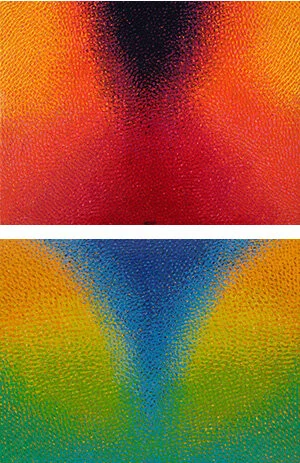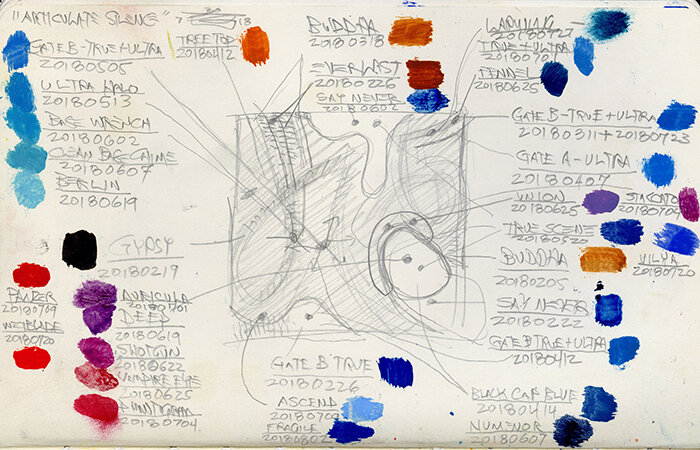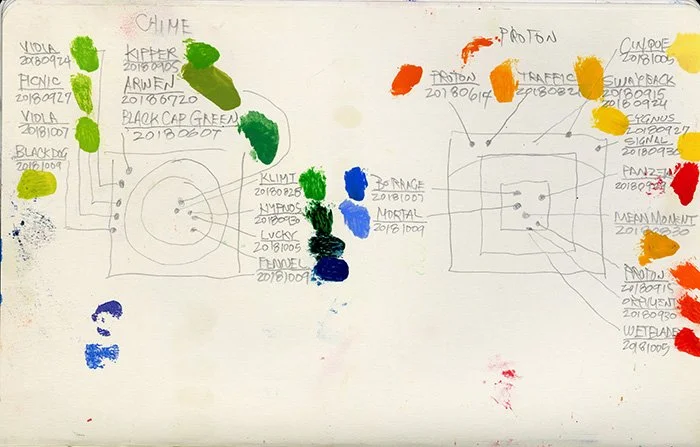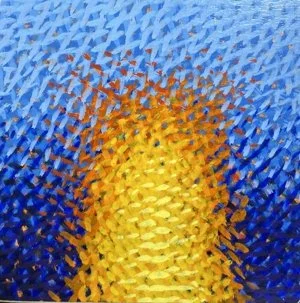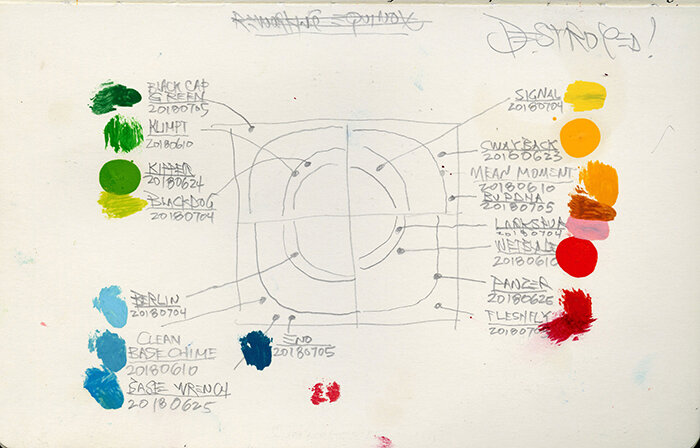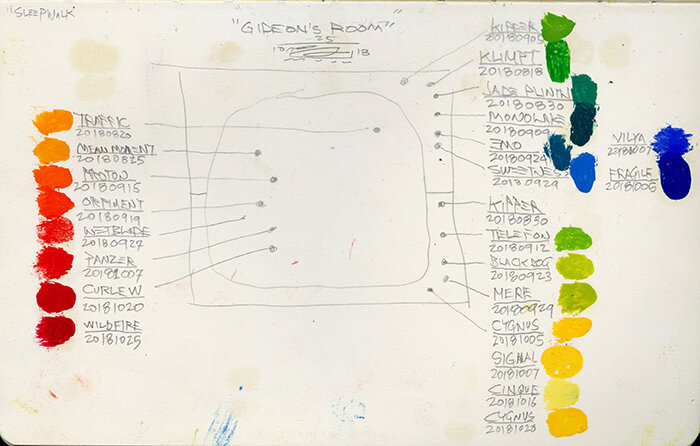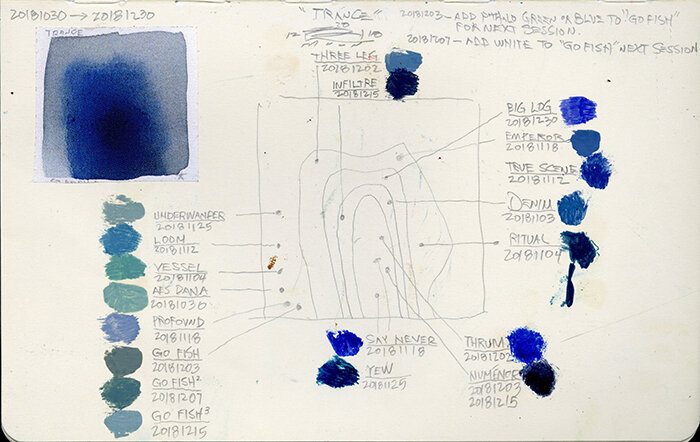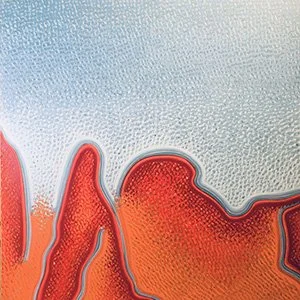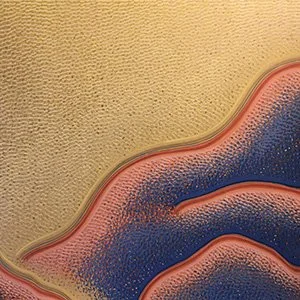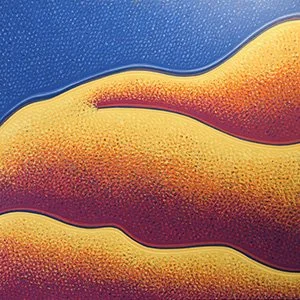Olorin was a sketchbook confined to my studio. I used it, at first, just to sketch out projects or to doodle, but it quickly got co-opted into keeping color diagrams of my abstract oil paintings.
Olorin 001 verso - Pencil on Moleskine paper
5in x 8in, 13cm x 20cm. 100USD
Olorin 002 - Pencil on Moleskine paper
5in x 8in, 13cm x 20cm. 100USD
Olorin 002 verso and 003- Pencil on Moleskine paper
10in x 8in, 25cm x 20cm.
Olorin 003 verso and 004 - Pencil and Caran d’Ache on Moleskine paper
10in x 8in, 25cm x 20cm.
Olorin 005 - Pencil on Moleskine paper
5in x 8in, 13cm x 20cm. 100USD
Olorin 005 verso and 006- Pencil on Moleskine paper
10in x 8in, 25cm x 20cm.
Olorin 008 - Pencil on Moleskine paper
5in x 8in, 13cm x 20cm. 100USD
Olorin 009 - Pencil on Moleskine paper
5in x 8in, 13cm x 20cm. 100USD
Olorin 010 - Pencil on Moleskine paper
5in x 8in, 13cm x 20cm. 100USD
Olorin 012 - Pencil on Moleskine paper
5in x 8in, 13cm x 20cm. 100USD
Olorin 012 verso - Pencil and oil dabs on Moleskin paper, 5in x 8in, 13cm x 20cm.
I learned the hard way to begin keeping diagrams of my abstracts.
I’d lose track of the exact color I had applied as I worked on multiple paintings.
Divine Radiance. Finished painting.
Olorin 013 - Pencil and oil dabs on Moleskin paper. 5in x 8in. 13cm x 20cm.
I don’t often try to depict “real” things with my abstracts, mostly because they end up being awful. I destroyed this painting after three months of work.
Tightrope - Finished painting.
Olorin 013 verso - Pencil and oil dabs on Moleskin paper, 5in x 8in, 13cm x 20cm.
Olorin 014 - Pencil and oil dabs on Moleskin paper, 5in x 8in, 13cm x 20cm.
Broken Light - Finished painting.
Vertiphon and Perpetual - Finished paintings.
As I went along, I learned not to crush two diagrams onto a single page.
Olorin 014 verso - Pencil and oil dabs on Moleskin paper, 5in x 8in, 13cm x 20cm.
Olorin 015 - Pencil and oil dabs on Moleskin paper, 5in x 8in, 13cm x 20cm.
I did a series of glyph sketches that I loved. I tried to turn them into paintings, but they were quite disappointing when painted large. One of them survived, but the rest had to go.
Olorin 015 verso - Pencil and oil dabs on Moleskin paper, 5in x 8in, 13cm x 20cm.
This was the only glyph painting that withstood scrutiny.
Articulate Silence - Finished painting.
Touch Of Heartbreak - Finished painting.
Olorin 016 - Pencil and oil dabs on Moleskine paper
5in x 8in, 13cm x 20cm.
Embers Of Sadness / Still Glow - Finished paintings.
I enjoy a diptych when I see them in homes and museums, so I thought I’d give it a try.
Olorin 016 verso - Pencil and oil dabs on Moleskin paper, 5in x 8in, 13cm x 20cm.
Olorin 018 - Pencil and oil dabs on Moleskin paper, 5in x 8in, 13cm x 20cm.
Aerodynamic - Finished painting.
Signal To Noise- Finished painting.
Though I originally intended this painting to be horizontal, once it was finished, I liked it much better viewed vertically.
Olorin 017 verso - Pencil and oil dabs on Moleskin paper, 5in x 8in, 13cm x 20cm.
Olorin 018 - Pencil and oil dabs on Moleskin paper, 5in x 8in, 13cm x 20cm.
Uprising - Finished painting.
Nothing Ever Happens In June - Finished painting.
Another painting that I decided looked better when vertical.
Olorin 018 verso - Pencil and oil dabs on Moleskin paper, 5in x 8in, 13cm x 20cm.
Olorin 019 - Pencil and oil dabs on Moleskin paper, 5in x 8in, 13cm x 20cm.
Tarantula - Finished painting.
The Same Deep Water As You - Finished painting.
Olorin 019 verso - Pencil and oil dabs on Moleskin paper, 5in x 8in, 13cm x 20cm.
Olorin 020- Pencil and oil dabs on Moleskin paper, 5in x 8in, 13cm x 20cm.
Remember Me As A Time Of Day - Finished painting.
Torque - Finished painting.
Favorite - Finished painting.
Olorin 020 verso - Pencil and oil dabs on Moleskin paper, 5in x 8in, 13cm x 20cm.
Olorin 021- Pencil and oil dabs on Moleskin paper, 5in x 8in, 13cm x 20cm.
Bliss - Finished painting.
Legend - Finished painting.
Chime - Finished painting.
Proton - Finished painting.
Olorin 021 verso - Pencil and oil dabs on Moleskine paper
5in x 8in, 13cm x 20cm.
Crocus - Finished painting.
Sin - Finished painting.
Touch Of Heartbreak - Finished painting.
Olorin 022 - Pencil and oil dabs on Moleskine paper
5in x 8in, 13cm x 20cm.
Olorin 022 verso - Pencil and oil dabs on Moleskin paper, 5in x 8in, 13cm x 20cm.
This was one of a handful of early paintings that I tried to “improve” a year or two after finishing them. It did not go well.
Olorin 023 - Pencil and oil dabs on Moleskin paper, 5in x 8in, 13cm x 20cm.
Olorin 023 verso - Pencil and oil dabs on Moleskin paper, 5in x 8in, 13cm x 20cm.
Olorin 024 - Pencil and oil dabs on Moleskin paper, 5in x 8in, 13cm x 20cm.
I believed that a painting done in many layers would lend itself to rework, if necessary.
I was wrong. There is a harmony of color and intent that must be present from the beginning, at least for me.
Olorin 024 verso - Pencil and oil dabs on Moleskin paper, 5in x 8in, 13cm x 20cm.
Unlike the others above, which started out as good paintings that I tried to make better, this one was cursed from the beginning.
I hate to give up, which is why there are so many layers on this before I destroyed it.
Olorin 025 - Pencil and oil dabs on Moleskin paper, 5in x 8in, 13cm x 20cm.
Arrival - Finished painting.
Cheops - Finished painting.
Olorin 025 verso - Pencil and oil dabs on Moleskine paper
5in x 8in, 13cm x 20cm.
Diamonds In The Grass - Finished painting.
Olorin 026 - Pencil and oil dabs on Moleskin paper, 5in x 8in, 13cm x 20cm.
Olorin 026 verso- Pencil and oil dabs on Moleskin paper, 5in x 8in, 13cm x 20cm.
Cue - Finished painting.
Stairway - Finished painting.
Olorin 027 - Pencil and oil dabs on Moleskin paper, 5in x 8in, 13cm x 20cm.
Olorin 027 verso - Pencil and oil dabs on Moleskin paper, 5in x 8in, 13cm x 20cm.
The Tenth Of Always - Finished painting.
Gideon’s Room - Finished painting.
Olorin 028 - Pencil and oil dabs on Moleskin paper, 5in x 8in, 13cm x 20cm.
Olorin 028 verso - Pencil and oil dabs on Moleskin paper, 5in x 8in, 13cm x 20cm.
One rainy October day in 2018, I sat down at my desk, pulled out my watercolors, and 50 or so tiny studies dazzled out of my mind and into my hand. The sketches produced were captivating, and I wondered how they would look writ large.
The Monoliths were born, and they grew to eclipse everything else I was working on for over a year.
Morning Room - Finished painting.
Behold - Finished painting.
I made color copies of the little watercolor studies, and pasted them into my sketchbook before beginning each oil painting. Each of my paintings stretches out over 3-9 months of execution, and the studies were instrumental in keeping me focused on what I thought the finished painting should reflect upon completion.
Olorin 029 - Pencil and oil dabs on Moleskin paper, 5in x 8in, 13cm x 20cm.
Olorin 029 verso - Pencil and oil dabs on Moleskin paper, 5in x 8in, 13cm x 20cm.
Sometimes the color on the oil painting would shift away from the watercolor study, and that was acceptable. The important part of my painting process is manipulating the way color resonates against the other colors layered on top of it. I’m trying to create a beautiful mesh that ensnares time.
Broken - Finished painting.
Trance - Finished painting.
Olorin 030 - Pencil and oil dabs on Moleskin paper, 5in x 8in, 13cm x 20cm.
Olorin 030 verso - Pencil and oil dabs on Moleskin paper, 5in x 8in, 13cm x 20cm.
Seeth - Finished painting.
Satin - Finished painting.
I work on eight to ten paintings at a time, cycling through them until they are done. When I finish one, I cycle in another. This gives each painting a week or two to dry between layers. It also means that I sometimes forget what I want the next layer of color to be. So I started adding notes on my diagram about my intentions for the next session.
Olorin 031 - Pencil and oil dabs on Moleskin paper, 5in x 8in, 13cm x 20cm.
Olorin 031 verso - Pencil and oil dabs on Moleskin paper, 5in x 8in, 13cm x 20cm.
Bemuse - Finished painting.
Phantom - Finished painting.
Olorin 032 - Pencil and oil dabs on Moleskin paper, 5in x 8in, 13cm x 20cm.
Olorin 032 verso- Pencil and oil dabs on Moleskin paper, 5in x 8in, 13cm x 20cm.
Veil - Finished painting.
Vibrant - Finished painting.
Olorin 033 - Pencil and oil dabs on Moleskin paper, 5in x 8in, 13cm x 20cm.
Olorin 033 verso - Pencil and oil dabs on Moleskin paper, 5in x 8in, 13cm x 20cm.
I have over 200 individual jars of paint, and some of the color differences are quite nuanced. Naming them became of paramount importance, not only so I could tell them apart in artificial light, but because as the painting progressed I knew which series of colors needed to be applied over multiple sessions. You can see my note in the lower left about color progression.
Melt - Finished painting.
Verdant - Finished painting.
Olorin 034 - Pencil and oil dabs on Moleskin paper, 5in x 8in, 13cm x 20cm.
Olorin 034 verso - Pencil and oil dabs on Moleskin paper, 5in x 8in, 13cm x 20cm.
Ardor - Finished painting.
Wander - Finished painting.
Olorin 035 - Pencil and oil dabs on Moleskin paper, 5in x 8in, 13cm x 20cm.
Olorin 035 verso - Pencil and oil dabs on Moleskin paper, 5in x 8in, 13cm x 20cm.
Lustre - Finished painting.
Sudden - Finished painting.
Olorin 036 - Pencil and oil dabs on Moleskin paper, 5in x 8in, 13cm x 20cm.
Olorin 036 verso - Pencil and oil dabs on Moleskin paper, 5in x 8in, 13cm x 20cm.
Plunge - Finished painting.
Coy - Finished painting.
Most of my work is 24 inches or larger. I do smaller works on occasion, but they always look a little rough to me. The photos of the small ones do let you see just how many hatch marks go into the overall mesh. Frankly, none of them photograph that well. You need to see them in person to enjoy them fully. This one is eleven inches square.
Olorin 037 - Pencil and oil dabs on Moleskin paper, 5in x 8in, 13cm x 20cm.
Olorin 037 verso - Pencil and oil dabs on Moleskin paper, 5in x 8in, 13cm x 20cm.
Nectar - Finished painting.
Spirit - Finished painting.
Olorin 038 - Pencil and oil dabs on Moleskin paper, 5in x 8in, 13cm x 20cm.
Olorin 038 verso - Pencil and oil dabs on Moleskin paper, 5in x 8in, 13cm x 20cm.
Mass - Finished painting.
Angst - Finished painting.
Olorin 039 - Pencil and oil dabs on Moleskin paper, 5in x 8in, 13cm x 20cm.
Olorin 039 verso - Pencil and oil dabs on Moleskin paper, 5in x 8in, 13cm x 20cm.
Spire - Finished painting.
Dawn - Finished painting.
Olorin 040 - Pencil and oil dabs on Moleskin paper, 5in x 8in, 13cm x 20cm.
Olorin 040 verso - Pencil and oil dabs on Moleskin paper, 5in x 8in, 13cm x 20cm.
Kindle - Finished painting.
Myth - Finished painting.
Olorin 041 - Pencil and oil dabs on Moleskin paper, 5in x 8in, 13cm x 20cm.
Olorin 041 verso - Pencil and oil dabs on Moleskin paper, 5in x 8in, 13cm x 20cm.
Moss - Finished painting.
Pitch - Finished painting.
Olorin 042 - Pencil and oil dabs on Moleskin paper, 5in x 8in, 13cm x 20cm.
Olorin 042 verso - Pencil and oil dabs on Moleskin paper, 5in x 8in, 13cm x 20cm.
Flux - Finished painting.
In mid-September of 2019, Stacey and I had managed to save enough money to take a week vacation to the Dominican Republic. It was our first beach vacation, and I spent the majority of time reading and drinking. There was a marvelous day by the beach that I became mesmerized by how the surf broke on the beach. I took a bunch of pictures, formatted them square, and interpreted them in various colour combinations.
Froth - Finished painting.
Olorin 043 - Pencil and oil dabs on Moleskine paper
5in x 8in, 13cm x 20cm.
Coast - Finished painting.
Olorin 043 verso - Pencil and oil dabs on Moleskine paper
5in x 8in, 13cm x 20cm.
Ripple - Finished painting.
Olorin 044 - Pencil and oil dabs on Moleskine paper
5in x 8in, 13cm x 20cm.
Cephalopod - Finished painting.
Olorin 044 verso - Pencil and oil dabs on Moleskine paper
5in x 8in, 13cm x 20cm.
Ebb - Finished painting.
Olorin 045 - Pencil and oil dabs on Moleskine paper
5in x 8in, 13cm x 20cm.
Strand - Finished painting.
Olorin 045 verso - Pencil and oil dabs on Moleskine paper
5in x 8in, 13cm x 20cm.
Breaker - Finished painting.
Olorin 046 - Pencil and oil dabs on Moleskine paper
5in x 8in, 13cm x 20cm.
Turbulence - Finished painting.
Olorin 046 verso - Pencil and oil dabs on Moleskine paper
5in x 8in, 13cm x 20cm.
Flow - Finished painting.
Olorin 047 - Pencil and oil dabs on Moleskine paper
5in x 8in, 13cm x 20cm.
Dune - Finished painting.
Olorin 047 verso - Pencil and oil dabs on Moleskine paper
5in x 8in, 13cm x 20cm.
Surge - Finished painting.
Olorin 048 - Pencil and oil dabs on Moleskine paper
5in x 8in, 13cm x 20cm.
Regatta - Finished painting.
Olorin 048 verso - Pencil and oil dabs on Moleskine paper
5in x 8in, 13cm x 20cm.

















